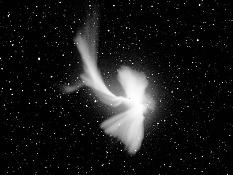
| Bad Astronomy |
|
|
|
BA Blog
|
|
Q & BA
|
|
Bulletin Board
|
| Media |
|
|
|
Bitesize Astronomy
|
|
Bad Astro Store
|
|
Mad Science
|
|
Fun Stuff
|
| Site Info |
|
|
|
Links
|
| RELATED SITES |
| - Universe Today |
| - APOD |
| - The Nine Planets |
| - Mystery Investigators |
| - Slacker Astronomy |
| - Skepticality |
Buy My Stuff

Keep Bad Astronomy close to your heart, and help make me
filthy rich. Hey, it's either this or one of those really
irritating PayPal donation buttons here.
A Leonid Explodes
Week of January 25, 1999On occasion, I will take a few weeks to explore a theme in astronomy on these pages. In 1997 that theme was the solar system. This time, for the next few weeks, I invite you to take a look at the Universe In Motion.
We think of the skies as static, unchanging. The only motions we see easily are the rising and setting of the Sun, Moon and stars, but that is a reflection of our own Earth's rotation. The stars themselves don't seem to move at all among themselves, and it takes a keen eye to discern the motion of the planets, which takes days or weeks to become obvious.
Yet objects in the sky are in constant motion, and some move with an incredible intrinsic velocity. Usually, these objects are so far away that the distance itself shrinks the apparent motion, the way distant mountains hardly seem to move at all even though you may be driving past them at 100 kilometers an hour. Sometimes it does take many years to perceive the movement of heavenly bodies, and sometimes it happens in the blink of an eye. Every Monday, we'll take a look at some of these celestial travelers.
Our first step in catching the Universe in motion starts close to home. Every November, the Leonid meteor shower peaks with a typical rate of 20 or so meteors an hour. Every 33 years or so, however, the shower can turn into a storm of meteors, with thousands an hour flashing across the sky. In 1998, the shower did have a large peak, though smaller than expected. Still, it did provide some spectacular entertainment. I was able to see some Leonids in 1998, and it was a lot of fun; you might wait minutes scanning the apparently motionless stars, then suddenly see a meteor streak across the sky so fast you wonder if it was just an illusion. I took pictures as well, but unfortunately none came out; although I got lots of stars, I didn't catch any meteors.
 The Robotic Optical
Transient Search Experiment (ROTSE) was luckier
than I was. It scans
the skies looking for things that change quickly. Meteors certainly
qualify for that! A typical Leonid meteor moves about 100 kilometers
per second across our sky, making it one of the fastest moving
particles the Earth encounters. The energy of a meteor
depends very strongly on its speed, so a Leonid, with its
high velocity, is a very energetic meteor. Sometimes that incredible
energy makes the meteor explode. ROTSE caught just such
an explosion on November 17, 1998. The picture above is just
one frame of an animation
which you can see as an
animated GIF on the ROTSE website.
The Robotic Optical
Transient Search Experiment (ROTSE) was luckier
than I was. It scans
the skies looking for things that change quickly. Meteors certainly
qualify for that! A typical Leonid meteor moves about 100 kilometers
per second across our sky, making it one of the fastest moving
particles the Earth encounters. The energy of a meteor
depends very strongly on its speed, so a Leonid, with its
high velocity, is a very energetic meteor. Sometimes that incredible
energy makes the meteor explode. ROTSE caught just such
an explosion on November 17, 1998. The picture above is just
one frame of an animation
which you can see as an
animated GIF on the ROTSE website.
There is an irony here; while a meteor may flash across the sky in just a second or less, the cloud from the explosion took over thirty minutes to dissipate. Yet in the animation the dramatic explosion looks like it only takes a few seconds! ROTSE took one frame every minute to make the astonishing movie of the explosion. So the actual event took a half hour, but is compressed to a few seconds in the animation to make it easier to watch. I should add that this explosion may look dramatic, but the energy involved was actually pretty small. You needn't worry about one of these meteors cracking the Earth in half, despite what Hollywood tells you!. In my opinion, the Universe itself is a lot more dramatic, interesting and fun than any movie that tries to imitate it.
My thanks to regular reader Pete Banholzer for bringing the animation to my attention, and the wonderful folks at the Astronomy Picture of the Day website for finding the picture in the first place!
|
|
| THE PANTRY: ARCHIVE OF BITESIZE SNACKS |
|
|
| Subscribe to the Bad Astronomy Newsletter! |
| Talk about Bad Astronomy on the BA Bulletin Board! |